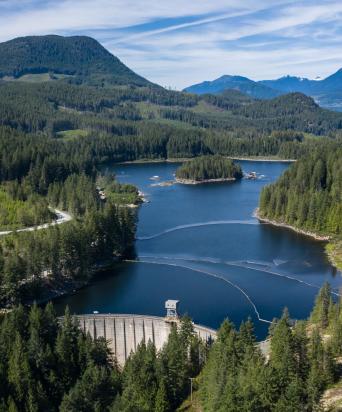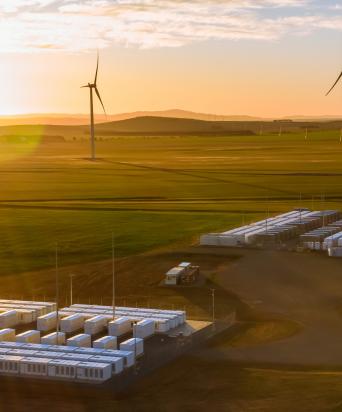Supercharging Sustainable Solutions
Rapidly rising corporate demand and supportive government policy will set sustainable solutions on a path to scale.
Executive Summary
- The next generation of climate technologies is ready to scale—and will play an essential role in decarbonizing hard-to-abate industries.
- These sustainable solutions include technologies and processes like battery storage, carbon capture, green hydrogen, recycling, biofuels, energy efficiency and nuclear power.
- Rapidly rising corporate demand is spurring substantial investment opportunities, with additional support from government policies like the U.S. Inflation Reduction Act (IRA).
- As long-term investors, we see several benefits to investing in sustainable solutions. Now is a pivotal moment for private capital to make a transformational impact on our climate future—while generating attractive risk-adjusted returns.
A New Success Story
Once upon a time, wind and solar power were simply too expensive to use. Governments stepped in to support them by providing subsidies and market incentives. As the technologies advanced, their costs eventually declined and they no longer required subsidies—for example, the price of solar panels dropped 99% over four decades to become the cheapest source of energy in many markets.1
Today, renewables are actively displacing traditional power generation as corporations increasingly procure renewable energy to lower their costs, reduce their carbon footprint and de-risk their operations with improved energy security. Global investment in clean energy is on course to rise to $1.8 trillion in 2023, with solar set to eclipse oil production for the first time.2
It is time for this success story to begin again. The next generation of climate technologies needs to scale in a similar way, as corporate demand for decarbonization solutions is growing rapidly. This is spurring significant near-term capital requirements and the need for operating expertise to scale up these solutions and drive down their costs. These technologies will also get a helping hand from pathfinding government policies like the U.S. Inflation Reduction Act (IRA), which will help catalyze close to $3 trillion in investments globally, according to Goldman Sachs.3
Global investment in clean energy is on course to rise to $1.8 trillion in 2023, with solar set to eclipse oil production for the first time
The window to keep global warming limited to 1.5°C is closing rapidly, and much more action is needed now on all fronts. Global investment in clean energy needs to rise to around $4.5 trillion per year by the early 2030s to be in line with the International Energy Agency’s (IEA) pathway to net zero by 2050.4 With this strong wave of corporate demand, supportive government regulations and transformational investment opportunity, the world is on the cusp of the next industrial revolution. We believe now is the time to invest—not only to help put the world on a path to net-zero emissions by 2050, but to earn potentially enhanced returns.
Defining Sustainable Solutions
“Sustainable solutions” is a broad term for the technologies and business models that will—and must—become ubiquitous in a net-zero economy.
These are proven and viable decarbonization asset classes such as biofuels, green hydrogen, carbon capture and storage (CCS) technology, electric vehicle charging infrastructure, boiler electrification, and other investments that improve and decarbonize energy-related infrastructure and enhance energy efficiency (see Figure 1). What they all have in common is that they are scalable low-carbon solutions and services that accelerate decarbonization across sectors or for a broad range of customers.
Some of these technologies can be implemented immediately into current or proven production methods to achieve decarbonization results. For example, biofuels or hydrogen can be used as a substitute for traditional natural gas; electric vehicle (EV) charging solutions can replace diesel-powered vehicles in transport; and carbon capture can be installed onto existing carbon-emitting production assets. As new technologies become established and then scale and mature, opportunities are likely to emerge in areas such as sustainable aviation fuels and direct air capture.
Figure 1: Sustainable Solutions
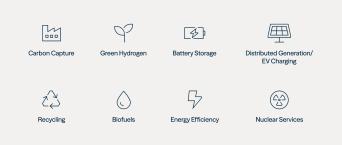
Sustainable solutions are fundamental to the energy transition because many of them are necessary to decarbonize hard-to-abate industries. This is a challenging step, but a crucial one alongside the rapid rollout of clean energy infrastructure because these industries contribute 30% of the world’s total emissions. Now, both corporations and governments are increasingly recognizing the role that these technologies will play in the transition, and that time is of the essence.
The projected market for decarbonization solutions is immense. For example, consider carbon capture and storage (CCS), which is a key solution for tackling the carbon footprint of existing assets and reducing the emissions of hard-to-abate sectors. Today, CCS sequesters approximately 40 million metric tons of carbon dioxide each year. By 2030, the IEA estimates that number will be 40 times higher, at approximately 1 billion metric tons per year. This means that CCS could eventually abate around 10%-15% of total global energy-related carbon dioxide emissions by 2050.5
Today, we see attractive opportunities for investors to move sustainable solutions quickly to their tipping point.
Corporate Demand Takes the Lead
Many businesses are now setting and progressing voluntary emissions reduction targets to reduce risk, maintain market share and remain competitive against peers. Over 8,000 companies have made commitments to net zero under the U.N.’s “Race to Zero” campaign.
These companies are not only motivated by their own decarbonization goals, but by the growing understanding that they are now competing on the carbon content of their products. Moreover, the U.S. Securities and Exchange Commission will soon require corporates to disclose the carbon emissions across their entire value chains.6 This means that their ability to secure financing and attract customers will increasingly depend on their ability to meet their emissions targets.
When it comes to sustainable solutions, demand will be closely tied to an important step along the path to net zero: decarbonizing hard-to-abate manufacturing processes. Industrial companies—which represent approximately 15% of total GHG emissions—are increasingly seeking large-scale capital investment in new production assets and a range of decarbonization solutions.
For instance, in the automotive and construction industries, some of the leading companies and largest purchasers of raw materials have made commitments to decarbonize their supply chain. Volvo has committed to using 100% green steel in its manufacturing process by 2050 as part of the industry-led SteelZero initiative. Ford has pledged to use 10% green steel by 2030 as part of the World Economic Forum’s First Mover coalition. And building manufacturing company Velux is targeting a 50% reduction across the value chain (scope 3 emissions) by 2030.7
Steelmakers are also moving in the right direction to meet this corporate demand. ArcelorMittal is transforming a plant in Ontario, Canada to reduce the carbon footprint and remove coal from the ironmaking process. “The new 2.5 million tonne capacity DRI [direct reduced iron] furnace will initially operate on natural gas but will be constructed ‘hydrogen ready’ so it can be transitioned to utilize green hydrogen as a clean energy input as and when a sufficient, cost-effective supply of green hydrogen becomes available,” according to the company.
ArcelorMittal is also leveraging carbon recycling technology from LanzaTech, a Brookfield portfolio company, to build a carbon capture and utilization facility in Ghent, Belgium. The “Steelanol” facility is a first of its kind for the European steel industry, and is designed to capture carbon-rich waste gases from steelmaking and biologically convert them into advanced ethanol. Brookfield’s partnership with Lanzatech will help provide these types of carbon capture and transition solutions to multiple corporations.
In the chemical industry, decarbonizing existing ammonia plants will require the use of carbon capture and storage. Ammonia is widely used in fertilizers and is responsible for approximately 1.8% of the world’s carbon dioxide emissions.8 Blue ammonia production is powered by fossil fuels, but the carbon is captured and either stored or repurposed for other uses. CF Industries plans to invest $198.5 million to construct a carbon dioxide compression and dehydration unit at its Ascension Parish plant in Louisiana. The project will reduce carbon emissions at what CF says is the largest ammonia production facility in the world.9
Given the ongoing emissions of heavy industrial operations, and the fact that 2050 is only a single investment cycle away, sustainable solutions need to scale quickly to allow emitters to reach their net-zero targets.
The Inflation Reduction Act Accelerates Progress
When U.S. President Biden signed the Inflation Reduction Act into law last year, critical elements were already in place for an acceleration in transition investment. Corporate demand was already high due to an increasing number of cost-effective decarbonization solutions, as well as both stricter environmental regulations and voluntary net-zero targets adopted as a response to COP 26.
The act provides an estimated $370 billion of financial incentives over the next decade to accelerate the transition to a clean energy economy (see Figures 2 and 3). Such commitment for such a long period is unprecedented. The IRA will help attract private capital, scale up supply chains, bring down costs and encourage innovation and deployment in clean energy sectors by providing straightforward, widely available and sufficient incentives.
Figure 2: Benefits of the Inflation Reduction Act Across Technologies
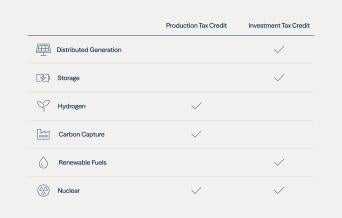
The IRA is likely to first help accelerate the widespread adoption of the already scaled technologies, such as solar and wind power and EVs, as well as the related transmission and storage of electricity. However, where the IRA will be most transformational is for the economics of the next wave of decarbonization technologies—not just in the U.S., but around the world.
The IRA also seeks to strengthen and reshape global supply chains. It includes incentives, such as subsidies to EV manufacturers and battery makers, to source components from the U.S. and its free-trade partners. For example, South Korean conglomerate Posco is planning to move its production of battery materials from mainland China to South Korea to qualify for U.S. tax incentives.10 Several of the tax credits and grants are also conditioned on or increased by satisfying minimum thresholds related to U.S. production.
While several details remain subject to IRS clarification, we expect the investment momentum to continue to strengthen as those details are ironed out. The upshot: All these tax credits help accelerate the already increasing tailwinds for clean energy and transition investment while easing the impact of any potential headwinds like higher inflation, rising interest rates, rising capex and supply constraints.
Figure 3: The Inflation Reduction Act Expands Incentives Covering Clean Technology Project Costs
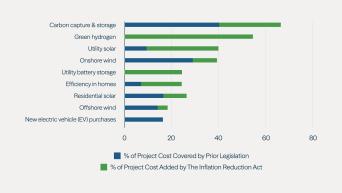
Source: Goldman Sachs, The Economist.
The IRA may be the most significant climate legislation in U.S. history. It has sent ripple effects around the world, with other regions creating similar support programs, such as the Green Deal Industrial Plan in the EU. All these will help accelerate the corporate-driven growth of sustainable solutions.
Just one example of how the IRA will enhance the clean energy landscape is by offering up to $3 per kilogram (kg) of support for clean hydrogen, depending on carbon intensity. This means the IRA could help bring clean hydrogen to parity with gray hydrogen, at $1 per kg. As clean hydrogen becomes more profitable, many midstream assets such as pipelines could be used to transport both renewable natural gas and hydrogen and potentially be fully repurposed for this alternative energy source. This could create investment opportunities for North American energy infrastructure companies while efficiently using existing assets.
Figure 4: U.S. Annual Solar Installations (MW)
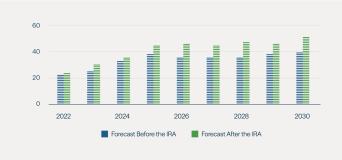
Source: BloombergNEF.
In addition, the IRA lays out incentives and reliability requirements that should help create a favorable environment for a wave of coal-to-nuclear (C2N) conversions. According to the U.S. Department of Energy, 80% of the nearly 400 retired and operating coal plants in the U.S. that it reviewed are candidates for C2N conversion.
Figure 5: Additions in U.S. Manufacturing Facilities
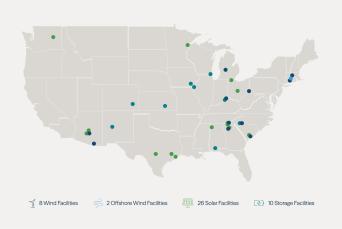
Source: American Clean Power, Wood Mackenzie, Nomura Greentech Analysis.
Investors, lenders, developers, energy producers and manufacturers are already beginning to see the impact. The IRA has helped attract over $270 billion in domestic utility-scale clean energy investments, such as solar installations and U.S. manufacturing facilities (see Figures 4 and 5).11 And announcements of low-carbon hydrogen projects have increased 58% since the act was signed into law in August 2022, according to BloombergNEF.12
The Momentum Is Clear
Both corporate demand and government incentives have never been stronger, and policymakers across the globe are in a race to the top to incentivize emissions reductions to achieve national climate targets. Such unprecedented government legislation and incentives will go a long way in allowing these technologies to scale faster than previously imagined—and making the investment case and potential returns even more attractive.
Such legislation arrived at a time when corporations were already planning on investing significant capital in decarbonizing their operations. The financial incentives the IRA and other programs provide only strengthen the value proposition and speed up the timeline for implementation. While some investors may be concerned that the IRA could be repealed, we note that it benefits constituents on both sides of the aisle.13 And regardless of what happens politically, it’s important to remember that corporate demand predates the legislation, and we expect it to continue to grow. Corporate demand is driving the trendline of decarbonization; government support is driving the ebb-and-flow above and below that trendline.
The investment opportunity is clear. Estimates of the total global investment to reach net zero vary considerably but all have very large totals. Studies have pegged total investment needed at anywhere from $200 trillion to $275 trillion through 2050.14 This year, about $1.7 trillion will be invested in clean energy, including renewable power, nuclear, grids, storage, low-emission fuels, efficiency improvements and end-use renewables and electrification, compared with $1 trillion in fossil fuel supply and power.15
As long-term investors, we see several benefits to investing in sustainable solutions. We can gain exposure to long-term cash flows underpinned by a defined corporate offtake revenue stream and policy tailwinds. Investments can also include structured downside protections, including legally contracted return floors. And with careful investment management, we can avoid technology risk and focus on proven, deployable technologies.
Sustainable solutions are critical to the transition because we cannot reach our net-zero goals without decarbonizing hard-to-abate industries. The IRA and other support programs supercharge the development of those technologies at a critical moment in time by enabling them to be mainstreamed more quickly. Brookfield is investing at the front end of that curve, prudently underwriting these technologies, including carbon capture and sequestration, green hydrogen, biofuels, energy storage, recycling and more.
Just like wind and solar power 10 years ago, or EVs five years ago, sustainable solutions are on the cusp of incredible growth. This is a pivotal moment for private capital to make a transformational impact on our climate future—while generating attractive risk-adjusted returns.
Endnotes
- Massachusetts Institute of Technology, “Explaining the plummeting cost of solar power,” November 20, 2018
- International Energy Agency, “Net Zero Roadmap: A Global Pathway to Keep the 1.5 °C Goal in Reach,” 2023 Update
- Goldman Sachs, “The US is poised for an energy revolution,” April 27, 2023
- IEA Net Zero Roadmap, 2023
- IEA, “Carbon Capture, Utilization and Storage,” July 11, 2023
- U.S. Securities and Exchange Commission, “SEC Proposes Rules to Enhance and Standardize Climate-Related Disclosures for Investors,” March 21, 2022
- Velux Group, Sustainability Report 2022
- The Royal Society, “Ammonia: zero-carbon fertiliser, fuel and energy store,” February 19, 2020
- Office of the Governor of Louisiana, “CF Industries Announces $198.5 Million Carbon Capture Project At Donaldsonville Complex,” August 5, 2022
- Financial Times, “Korea battery materials maker onshores China supply chain to win US subsidies,” August 13, 2023
- American Clean Power Association, April 17, 2023
- Bloomberg NEF, “Green Hydrogen Project Capacity Doubles 1 year Post IRA.”
- Financial Times, “Republican districts dominate US clean technology investment boom,” August 13, 2023
- BloombergNEF and McKinsey & Company, respectively
- International Energy Agency
Disclosures
This commentary and the information contained herein are for educational and informational purposes only and do not constitute, and should not be construed as, an offer to sell, or a solicitation of an offer to buy, any securities or related financial instruments. This commentary discusses broad market, industry or sector trends, or other general economic or market conditions. It is not intended to provide an overview of the terms applicable to any products sponsored by Brookfield Asset Management Ltd. and its affiliates (together, "Brookfield").
This commentary contains information and views as of the date indicated and such information and views are subject to change without notice. Certain of the information provided herein has been prepared based on Brookfield's internal research and certain information is based on various assumptions made by Brookfield, any of which may prove to be incorrect. Brookfield may have not verified (and disclaims any obligation to verify) the accuracy or completeness of any information included herein including information that has been provided by third parties and you cannot rely on Brookfield as having verified such information. The information provided herein reflects Brookfield's perspectives and beliefs.
Investors should consult with their advisors prior to making an investment in any fund or program, including a Brookfield-sponsored fund or program.

